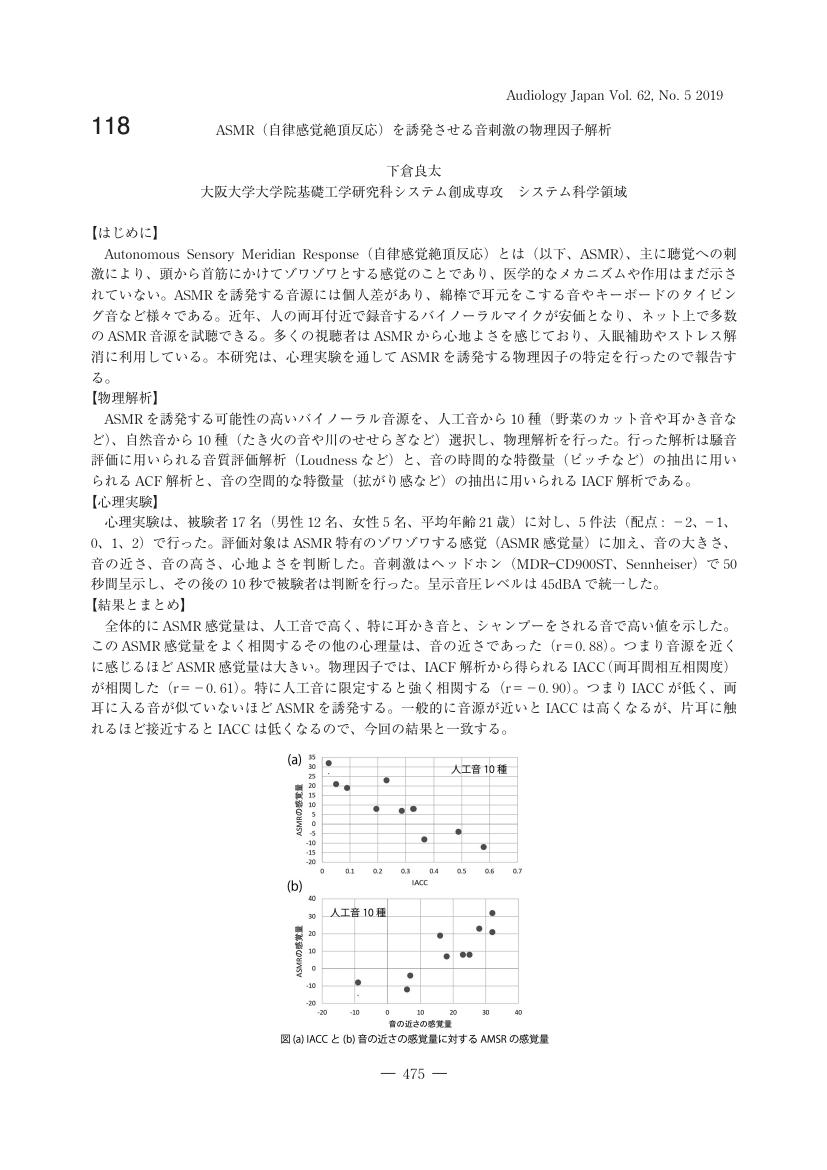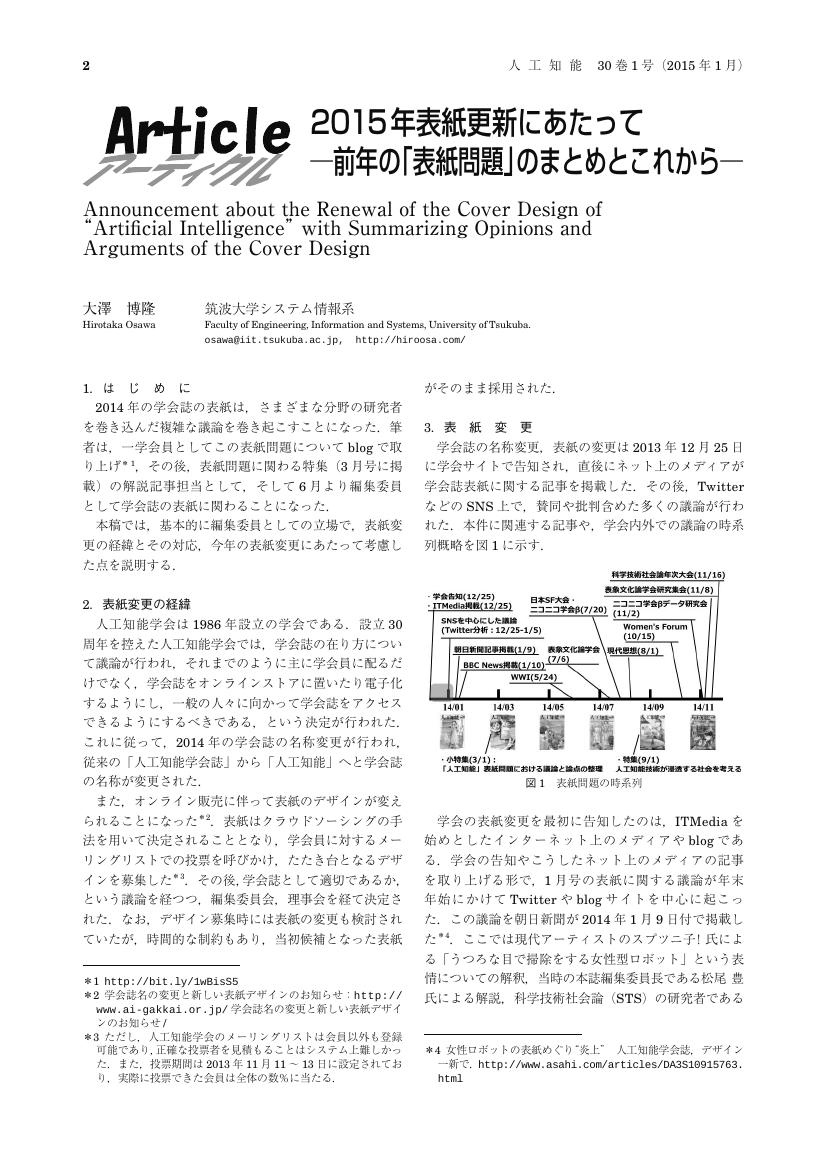9 0 0 0 21世紀におけるミサイル艇の存在意義 (特集・ミサイル艇)
9 0 0 0 OA 不可知とされがちな領域への接近 ―スポーツの記述とその理解及び共有について―
- 著者
- 海老田 大五朗 杉本 隆久
- 出版者
- 日本スポーツ社会学会
- 雑誌
- スポーツ社会学研究 (ISSN:09192751)
- 巻号頁・発行日
- vol.28, no.2, pp.9-25, 2020-09-30 (Released:2021-10-15)
- 参考文献数
- 38
本研究は、スポーツの記述についての、現象学から影響を受けた社会学の一分野であるエスノメソドロジー研究である。本研究の目的はスポーツを記述するときに、いわゆる身体知とされて他者から知ることができないとされることなどが、実際には記述の可能性に開かれていること、そしてこの記述可能性は私秘的なものではなく、そのスポーツに親しむ者であればだれでもアクセスできるものであることを、放映されたスポーツ番組にもとづきあきらかにすることである。 本研究では、不可知とされがちな領域を、「メディア的環境要因によるアクセス困難性」によって不可知とされがちな領域と、選手の内面的なものとされることで不可知とされがちな領域の2つに区分し、それぞれの領域におけるスポーツの記述と理解について分析した。その際、記述や理解のための参照リソースに焦点をあてた。前者はサッカー実践になじんでいるものであればだれでも知っているような規範や実践が主な参照リソースになっており、後者は瞬間的・反応的動きが可能になる理由を、「予期」や「確信」といった概念と結びつけられることで理解可能になっていることをあきらかにした。 本誌特集テーマと関連する「スポーツ指導の現場に役立つスポーツ社会学を構想する手がかり」として、このような分析によってえられる記述の位置づけについても考察した。本稿では、理解というものを身体的理解と概念連関的理解にわけて再定式化し、これら相互の翻訳可能性こそがスポーツのプラクティス(練習や実践)の源泉になることを示した。
9 0 0 0 漢文解釋における連文の利用
9 0 0 0 OA 超音波の生物作用と治療応用 ――遺伝子応答に基づく知見――
- 著者
- 近藤 隆 小川 良平 趙 慶利 田渕 圭章
- 出版者
- 一般社団法人 日本音響学会
- 雑誌
- 日本音響学会誌 (ISSN:03694232)
- 巻号頁・発行日
- vol.73, no.2, pp.108-113, 2017 (Released:2017-08-01)
- 参考文献数
- 14
9 0 0 0 OA 近年日本におけるポリオ流行の疫学的考察
- 著者
- 平山 雄
- 出版者
- 社団法人 大阪生活衛生協会
- 雑誌
- 生活衛生 (ISSN:05824176)
- 巻号頁・発行日
- vol.5, no.5, pp.179-185, 1961-10-10 (Released:2010-03-11)
- 参考文献数
- 31
9 0 0 0 OA ASMR (自律感覚絶頂反応) を誘発させる音刺激の物理因子解析
- 著者
- 下倉 良太
- 出版者
- 一般社団法人 日本聴覚医学会
- 雑誌
- AUDIOLOGY JAPAN (ISSN:03038106)
- 巻号頁・発行日
- vol.62, no.5, pp.475, 2019-10-30 (Released:2019-11-28)
9 0 0 0 OA 少女文化を読み解く/OTOME展によせて
- 著者
- 杉本 真理子 Mariko SUGIMOTO
- 出版者
- 神戸芸術工科大学
- 雑誌
- 芸術工学2011
- 巻号頁・発行日
- 2011-11-30
この報告は、2010年10月17日~27日まで、神戸市のギャラリーにて開催された「OTOME展」についてのものである。「おとめ」とは何か、ただ単に「女性」や「少女」をテーマにしただけのイラスト展ではなく、インターネットのない時代から現代まで「カルチャーの原点は雑誌である」という仮説のもと、日本で最初の「少女まんが」は何か、少女まんがに影響された「叙情画」とは何か、昭和初期と現在の少女の文化はどう変化していったかということと、サブカルチャーの今までのあり方、さらにこれからのあり方を想定し、社会的背景や、ジェンダーの問題がどのように少女文化に影響を与えたのか、などの問題をふまえた上で、現在流行している「タレント本」から、細分化された「まんが」「ゲーム」「ライトノベル」などに登場するキャラクターの変化や、また別の切り口として「少女まんがは異端の文化」である事を理論付け、男性から見た現代の「OTOME」の姿と、女性から見た原点の「OTOME」の像を、イラストという形態でアウトプットし、展示した時に生じる何らかの差異が表面化できるかどうか試みたのが、今回の主旨でもある。
9 0 0 0 OA 室内火災の現場より救出され,一酸化炭素中毒を合併したシアン中毒傷病者の1例
- 著者
- 岩崎 泰昌 奈女良 昭 宇根 一暢 太田 浩平 木田 佳子 廣橋 伸之 谷川 攻一
- 出版者
- 一般社団法人 日本救急医学会
- 雑誌
- 日本救急医学会雑誌 (ISSN:0915924X)
- 巻号頁・発行日
- vol.25, no.10, pp.797-803, 2014-10-15 (Released:2015-03-12)
- 参考文献数
- 12
室内など閉鎖空間での火災による傷病者は,熱傷の他に一酸化炭素中毒(CO)を合併することが多いが,同時に化学繊維などの燃焼で発生したシアン化水素の吸入によりシアン中毒を生じることがある。室内火災の現場から救出されCO中毒にシアン中毒を合併した1例を経験したので報告する。症例は18歳の男性。ビル内にある飲食店の一室で火災に巻き込まれて,消防により倒れているところを救助され,火災発生から約1時間後に当院救命救急センターへ搬送された。来院時,意識はGlasgow coma scale score 3,顔面にII度熱傷 7%,両手にIII度熱傷 5%を受傷しており,気道内に大量の煤を伴う気道熱傷を認めた。血中乳酸値は13.5mmol/Lで高度の乳酸アシドーシスを認め,carboxyhemoglobin(COHb)濃度は33.8%,来院から1時間後の血中シアン濃度は,4.3µg/mLであった。乳酸値は来院後12時間で正常化,100%酸素換気下でCOHb濃度は来院3時間後に5%以下,シアン濃度は来院4.5時間後に0.3µg/mLにそれぞれ低下したが,意識の回復は認めなかった。来院時の頭部CTでは,軽度の脳浮腫と皮髄境界の不鮮明化を呈し,第3病日には明らかな皮髄境界の消失と高度の脳浮腫が認められ,来院から6日後に低酸素脳症で死亡した。来院1時間後の血中シアン濃度は,致死レベルを越えていたことから,COHb濃度の上昇による酸素運搬障害に加えて,シアン中毒による脳細胞の細胞内窒息により,来院時からすでに高度の低酸素脳症が生じたものと考えられた。本症例では,シアン中毒の解毒薬であるヒドロキソコバラミンの投与はできなかったが,室内などの閉鎖空間での火災による傷病者に対しては,ヒドロキソコバラミンを早期に投与する必要性があると考えられた。
9 0 0 0 OA 2015年表紙更新にあたって : 前年の「表紙問題」のまとめとこれから(アーティクル)
- 著者
- 大澤 博隆
- 出版者
- 一般社団法人 人工知能学会
- 雑誌
- 人工知能 (ISSN:21882266)
- 巻号頁・発行日
- vol.30, no.1, pp.2-6, 2015-01-01 (Released:2020-09-29)
9 0 0 0 OA 戦後日本における「親韓」の意味
- 著者
- 黄 盛彬 ファン ソンビン Seongbin Hwang
- 雑誌
- 応用社会学研究 = The journal of applied sociology
- 巻号頁・発行日
- vol.59, pp.1-21, 2017-03-24
9 0 0 0 OA 腎臓内科領域の漢方治療
- 著者
- 小野 孝彦
- 出版者
- 一般社団法人 日本東洋医学会
- 雑誌
- 日本東洋医学雑誌 (ISSN:02874857)
- 巻号頁・発行日
- vol.64, no.1, pp.10-15, 2013 (Released:2013-07-20)
- 参考文献数
- 26
- 被引用文献数
- 2
近年,糖尿病性腎症,慢性腎炎,腎硬化症など各種の腎疾患をひとまとめにして慢性腎臓病と呼んでいる。レニン・アンジオテンシン系に働く治療薬は慢性腎臓病治療の第1選択とされているが,七物降下湯は併用効果が期待される。基礎的研究では糖尿病性腎症の進展に八味地黄丸の抑制効果がある。近年の研究から腎炎や一次性ネフローゼ症候群において,柴苓湯はステロイドや免疫抑制薬の減量効果が期待される。慢性腎炎やネフローゼ症候群の背景となる病態として,柴朴湯の治療は頻回の上気道炎を減少させ,柴苓湯はアレルギーの関与が考えられるネフローゼ症候群に対して効果的な場合が見られる。小児の IgA 腎症に対して,前向きの臨床試験による柴苓湯効果のエビデンスも得られている。透析に至る前の慢性腎不全に対して温脾湯は,透析導入への延長効果が知られている。五苓散は血液透析時の透析困難を改善し,腹膜透析においては腹膜線維化の問題点に対して柴苓湯の改善効果が期待される。
9 0 0 0 OA 電気自動車,太陽光パネル,蓄電池を用いた一般家庭の電力収支
- 著者
- 小倉 亜紗美
- 出版者
- 日本環境学会
- 雑誌
- 人間と環境 (ISSN:0286438X)
- 巻号頁・発行日
- vol.47, no.3, pp.45-51, 2021-10-10 (Released:2022-04-10)
- 参考文献数
- 5
9 0 0 0 OA Pharmacokinetics/Pharmacodynamics of Acetaminophen Analgesia in Japanese Patients with Chronic Pain
- 著者
- Shigeo Shinoda Takahiko Aoyama Yukio Aoyama Sachiko Tomioka Yoshiaki Matsumoto Yoko Ohe
- 出版者
- The Pharmaceutical Society of Japan
- 雑誌
- Biological and Pharmaceutical Bulletin (ISSN:09186158)
- 巻号頁・発行日
- vol.30, no.1, pp.157-161, 2007 (Released:2007-01-01)
- 参考文献数
- 27
- 被引用文献数
- 31 38
Acetaminophen (APAP) is a popular analgesic. In the present study, we characterized the pharmacokinetics and pharmacodynamics of APAP in the Japanese. Five healthy volunteers were administered 1000 mg of APAP orally. Five patients with chronic pain were administered the optimal oral dose of APAP ranging from 600 to 1000 mg to allow for an adequate analgesic effect. Plasma APAP and APAP metabolite concentrations were measured in the volunteers, plasma APAP concentrations and pain scores using a visual analog scale were measured in the patients with chronic pain. Patient data were fitted to a first-order absorption one-compartment model with delayed effects accounted for by an effect compartment. A sigmoid Emax model was used as the pharmacodynamic model. Acetaminophen-cysteine metabolites, which are conjugates of the toxic metabolite N-acetyl-p-benzoquinone-imine, were detected in the plasma at levels lower than 0.2 μg/ml, but no side effects were observed. The pharmacokinetic and pharmacodynamic parameter (mean±S.D.) estimates were as follows: clearance, 18.7±4.7 l/h; distribution volume, 30.9±6.8 l; absorption rate constant, 2.4±1.3 h−1; rate constant for the elimination of APAP from the effect compartment, 1.3±0.5 h−1; maximum pain relief score, 4.6±2.2 units; effect compartment concentration at 50% maximum, 2.0±1.2 μg/ml; and sigmoid factor, 1.3±0.7. These results suggest that these parameters can be used to determine an effective APAP dosage regimen for Japanese patients with chronic pain.
9 0 0 0 口伝の行進曲:維新期における山国隊の西洋ドラム奏法受容とその継承
- 著者
- 奥中 康人
- 出版者
- The Society for Research in Asiatic Music (Toyo Ongaku Gakkai, TOG)
- 雑誌
- 東洋音楽研究 (ISSN:00393851)
- 巻号頁・発行日
- no.70, pp.1-17,L1, 2005
Western military music or the drum and fife corps was diffused in every corner of the earth with expansion of colonization in the late 19th century. It was not the art music but the new technology of maintaining the order in an army, especially in drill of an infantry. Since this technology was often mixed with different cultures of music, it assimilated into local community. In Japan, a number of Western-style drum corps with Japanese bamboo flute were founded in the end of Edo period.<br>In the first part of this paper, I made clear the social context and role of drum and drummer in a platoon <i>Yamaguni</i>-<i>tai</i> which was organized voluntarily to enter into the Boshin Civil War (1868). The leader Itsuki Fujino's daily war report serves to attain this purpose. Because the drum call and march were essential to the stable operation of modern tactics, they must be trained elaboratively during the War under the signal of drummer boy, who was employed from outside. Snare drum made them develop their physical ability as soldiers. Just before the end of the War members of <i>Yamaguni</i>-<i>tai</i> had learned how to play the snare drum or flute in order to participate in a triumphant return from Edo to Kyoto. They handed down two repertories for this parade on the next generation: "<i>Koshinkyoku</i> [March]" and "<i>Reishiki</i> [Ceremony], " which would have represented the legitimacy of the new Meiji Government backing up the Mikado.<br>In the second part, I focused on their drumming. Although at the present time <i>Yamaguni</i>-<i>tai</i> dresses in period military costume and blows pentatonic melodies on the bamboo flutes, we can point out some evidences enough to prove that their playing manner have its roots on Western music. In <i>Yamaguni</i>-<i>tai</i> the performance has been memorized by means of the onomatopoeic words and graphic notation for drum. Based on careful observation and analysis of their presentation, it is obvious that these two tools indicated exactly player's bodily movements of both arms rather than the sound itself. This onomatopoeia including "<i>Hororon</i>" (=once five stroke roll) and "<i>En Tei</i>" (=twice flam; "<i>En Tei</i>" is derive from Dutch "een twee") corresponds to well-known drum exercises for stick control: Drum Rudiments. For that reason we can conclude <i>Yamaguni</i>-<i>tai</i> to be a fine example of acculturation of Western Music in Japan. It should be stressed that they have been able to continue their oral tradition since the Meiji Restoration just because of unawareness of the origin of their own drum method. If we tried to translate their music into Western musical notation which was familiar to us, their physical movements could never survive no longer.
- 著者
- Sanae Midorikawa Akira Ohtsuru
- 出版者
- The Japan Endocrine Society
- 雑誌
- Endocrine Journal (ISSN:09188959)
- 巻号頁・発行日
- vol.67, no.12, pp.1253-1255, 2020 (Released:2020-12-28)
- 参考文献数
- 15




